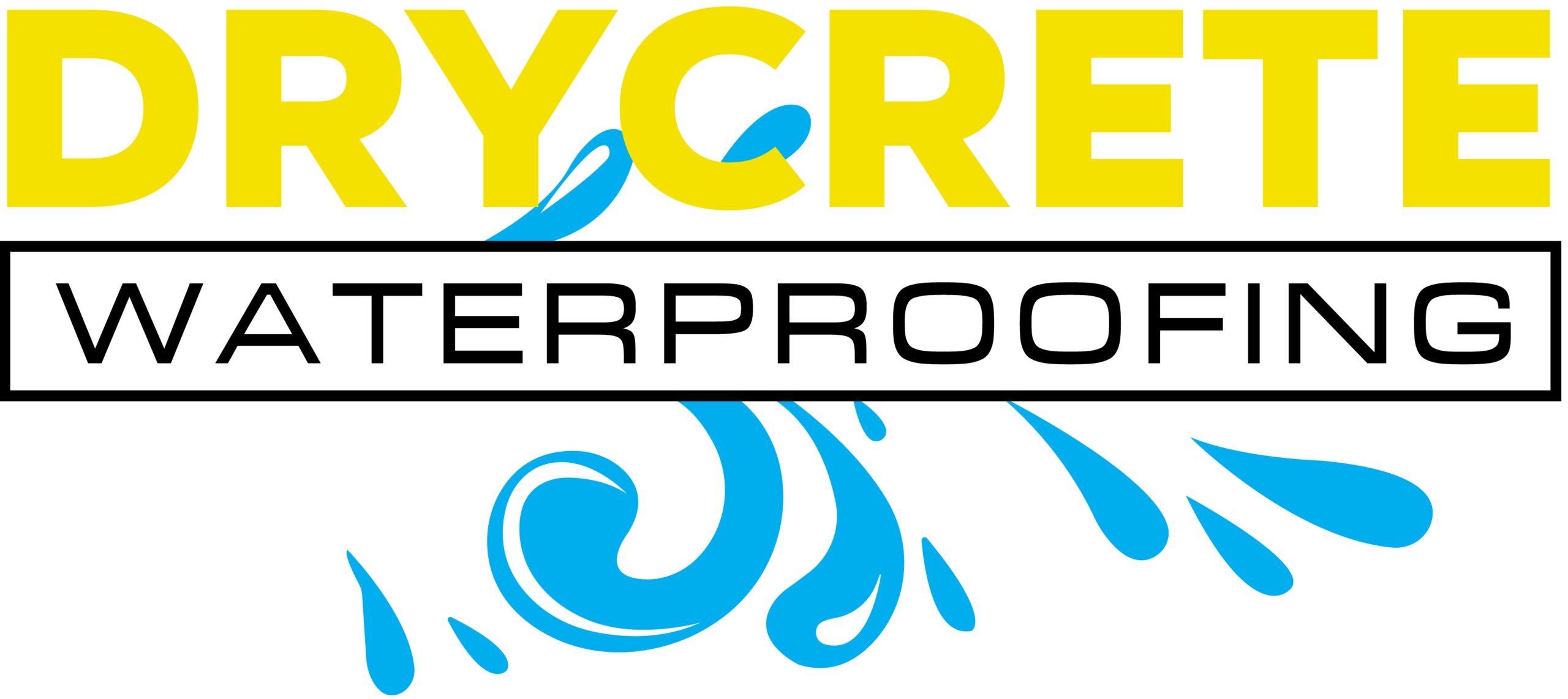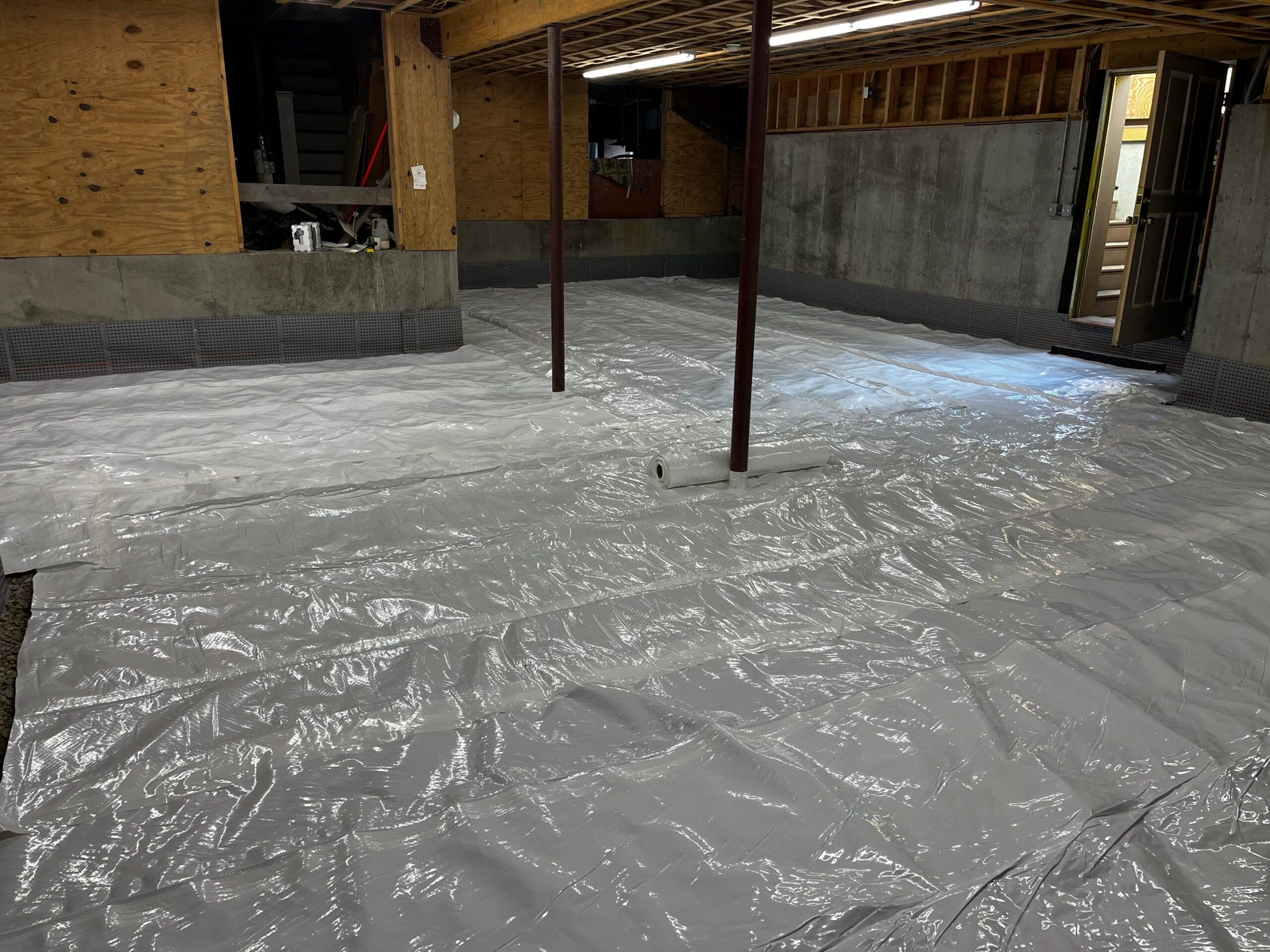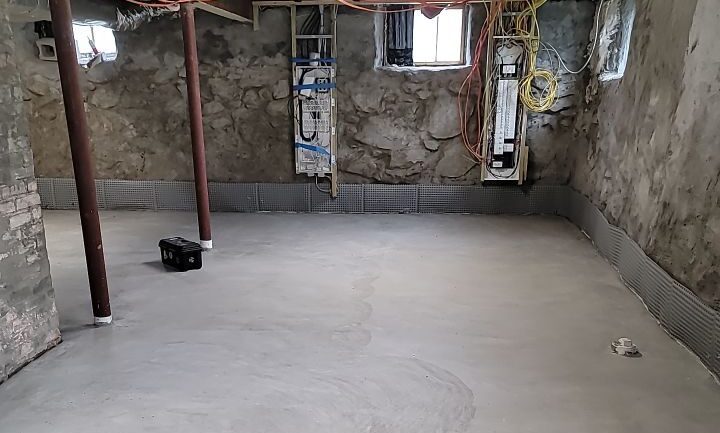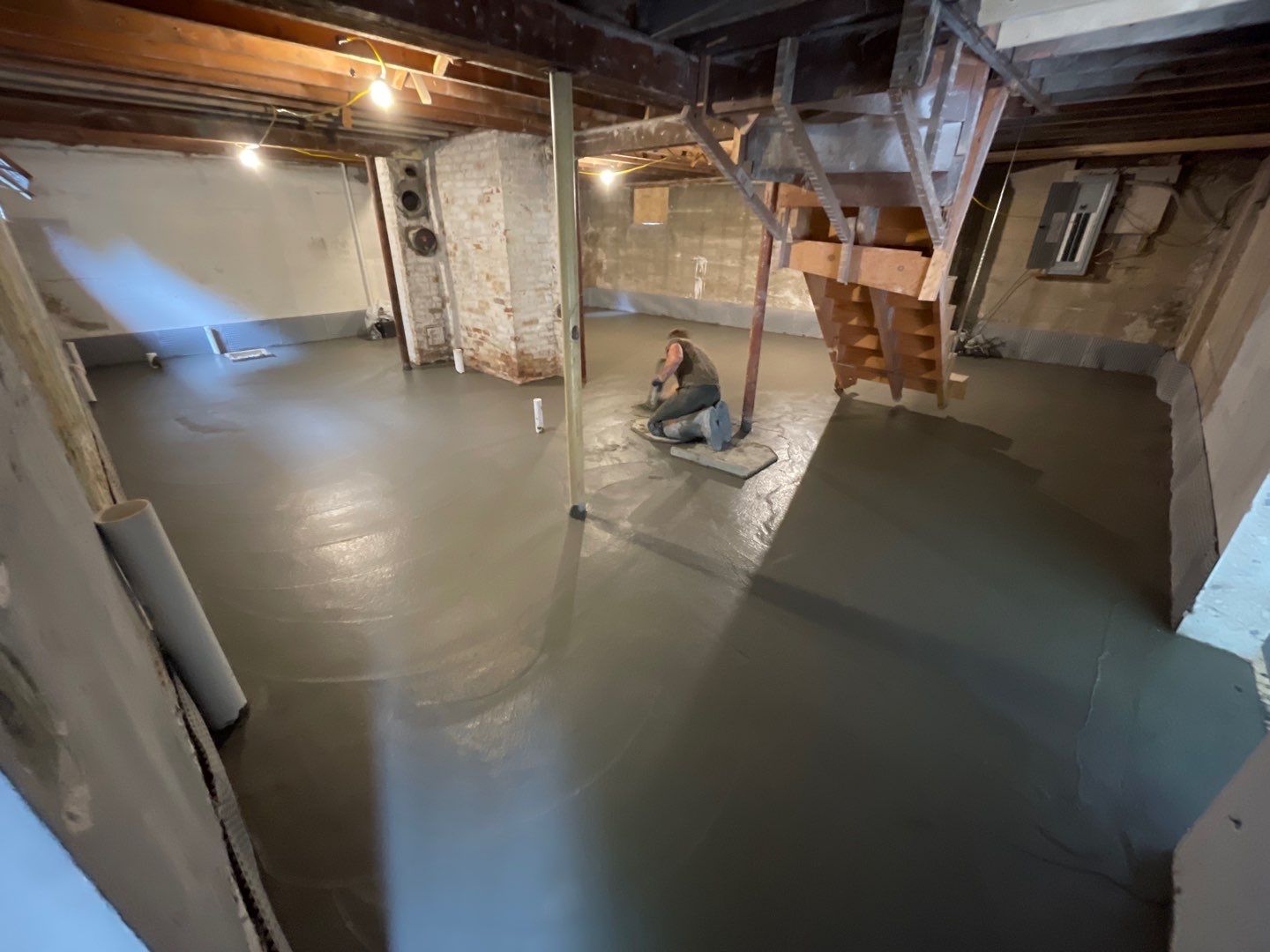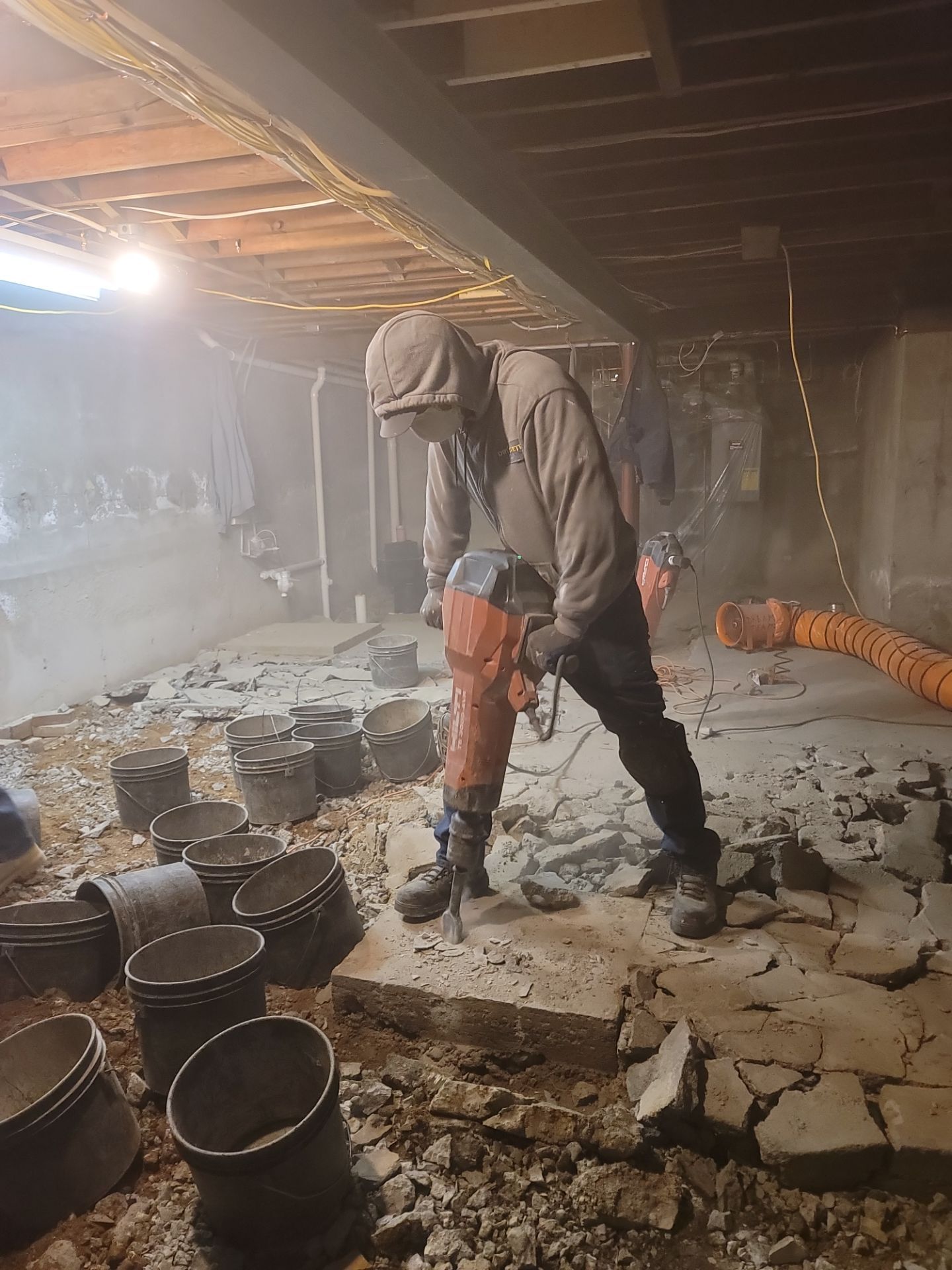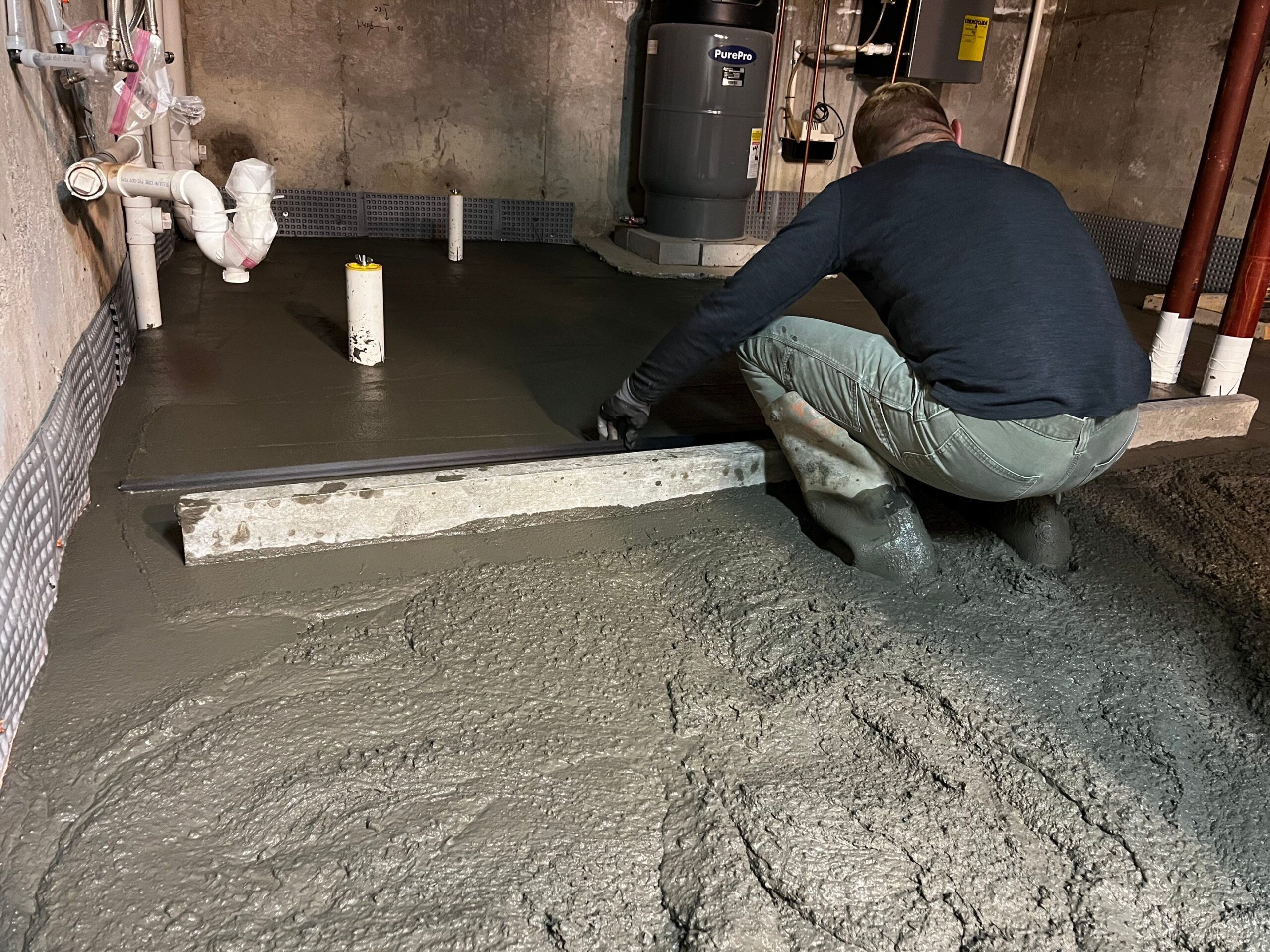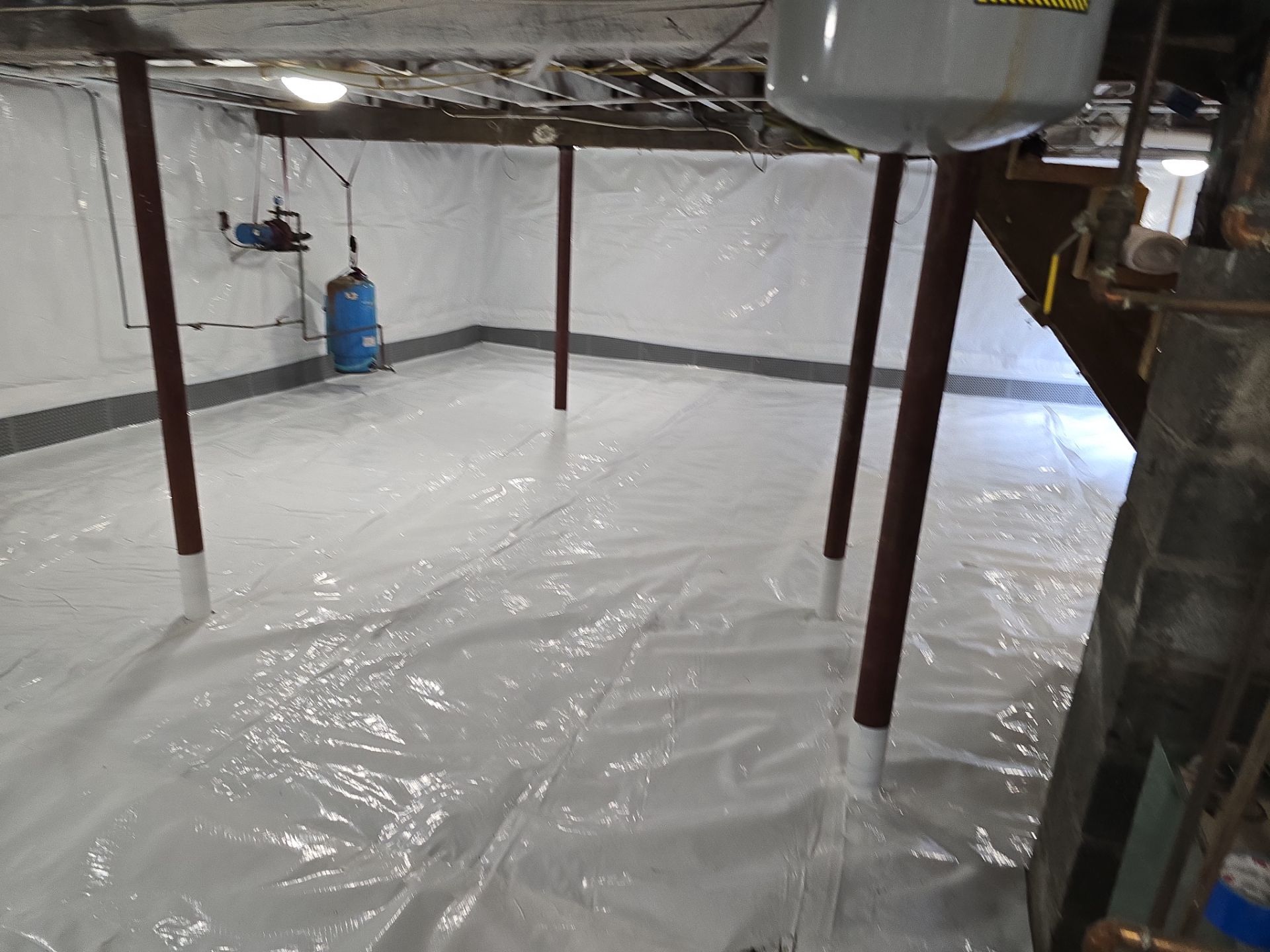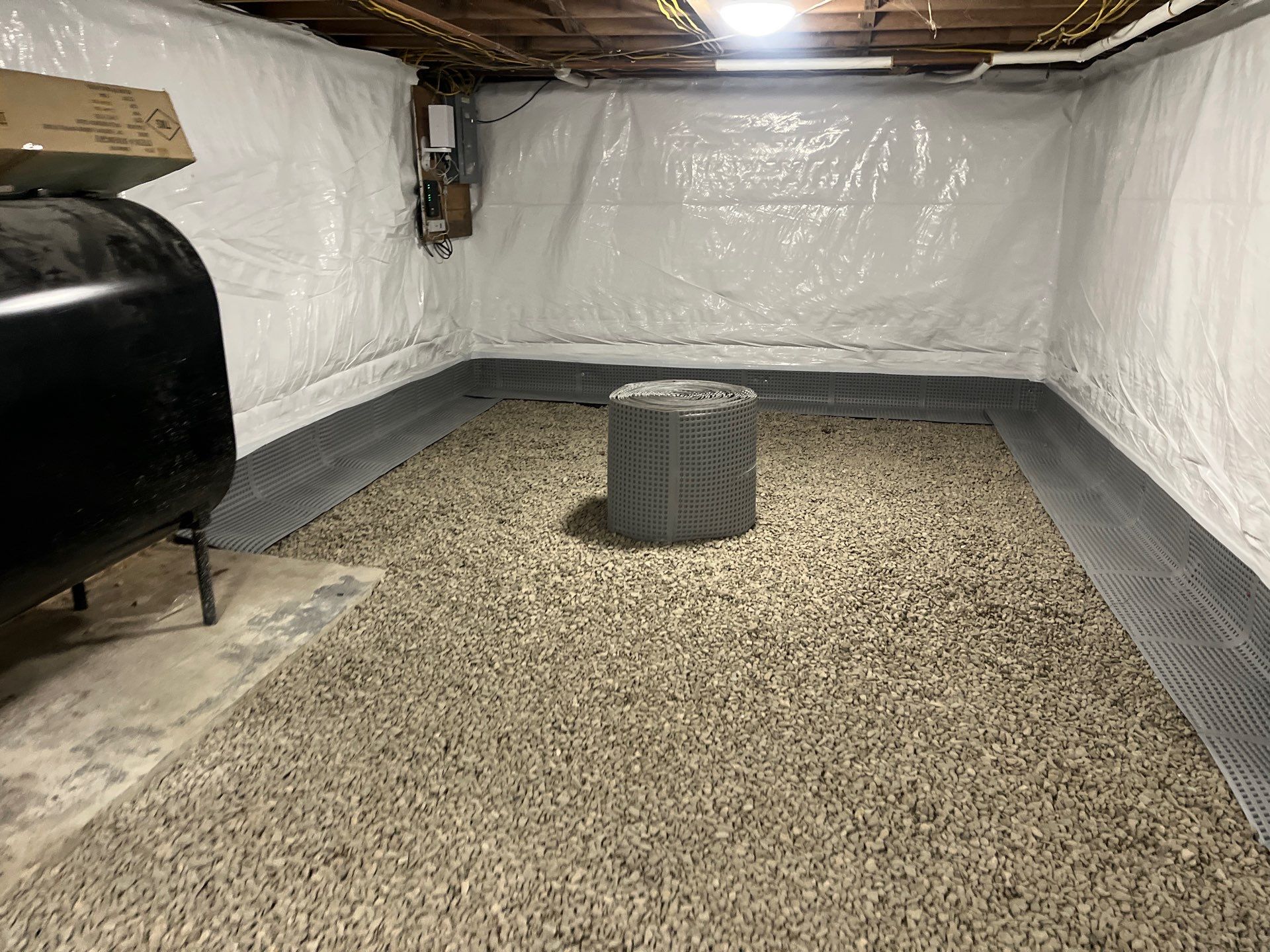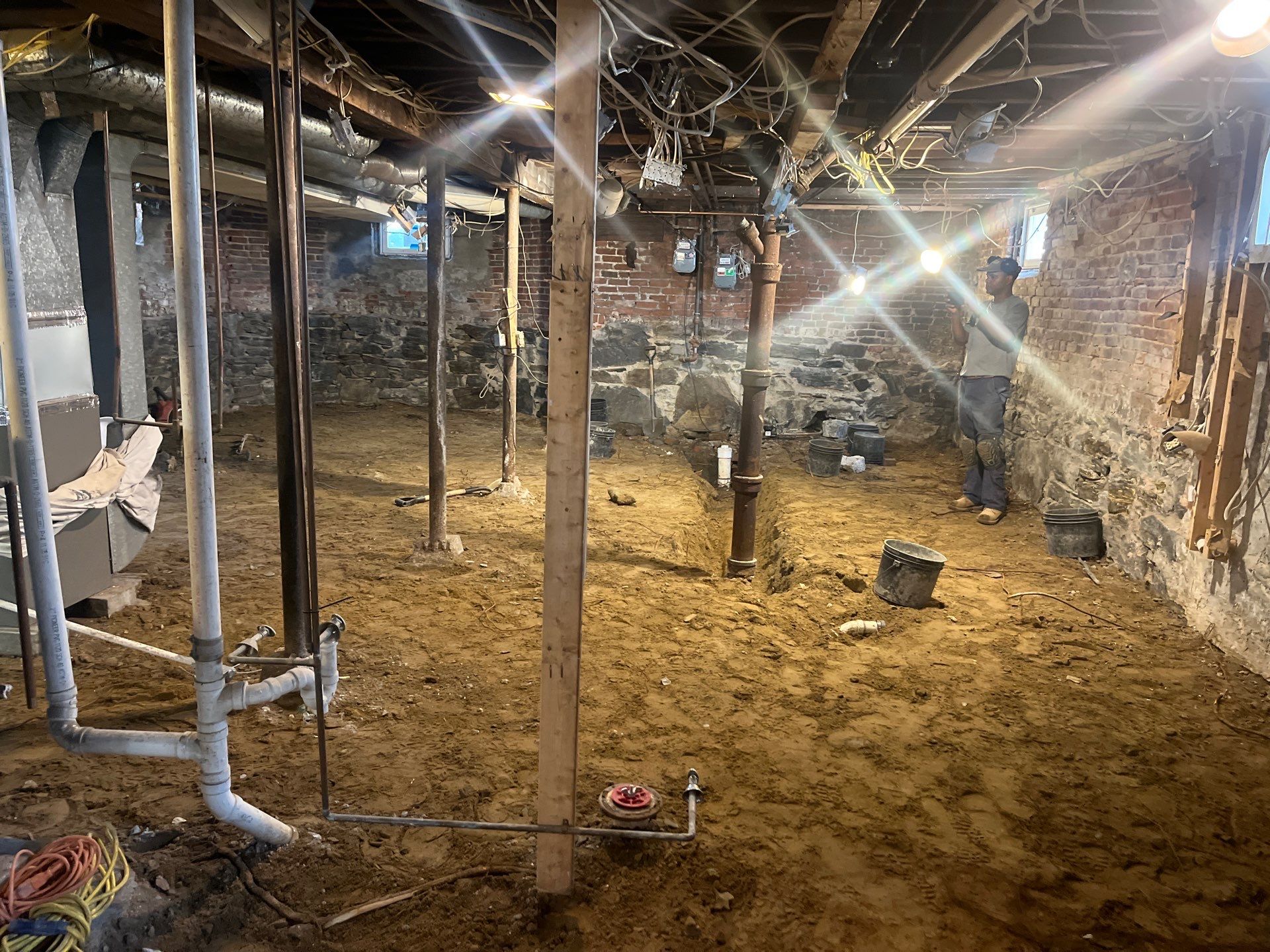You’re Getting a New Basement Slab: What to Expect
Replacing a basement slab is a significant project, and understanding the process can make everything smoother and less stressful. Knowing what steps to expect, how the slab is prepared, and how to care for it afterward will help you stay informed and confident throughout the project.
THE REPLACEMENT PROCESS
At Drycrete Waterproofing, we specialize in slab replacements that restore and enhance your space. From basements to garages, we handle every step of the process with precision and care.
Step 1: Site Preparation
The first step is to break up and remove your old slab. Then we dig down 6” to 8” into the subgrade material. This allows us to prep the slab properly without losing any headspace in your basement.

Step 2: Installation of a French Drain and Sump Pump System
With every slab replacement we incorporate a French drain system, so while we’re excavating the basement we dig a trench around the perimeter and install a drain system and sump pit with plenty of crushed stone.
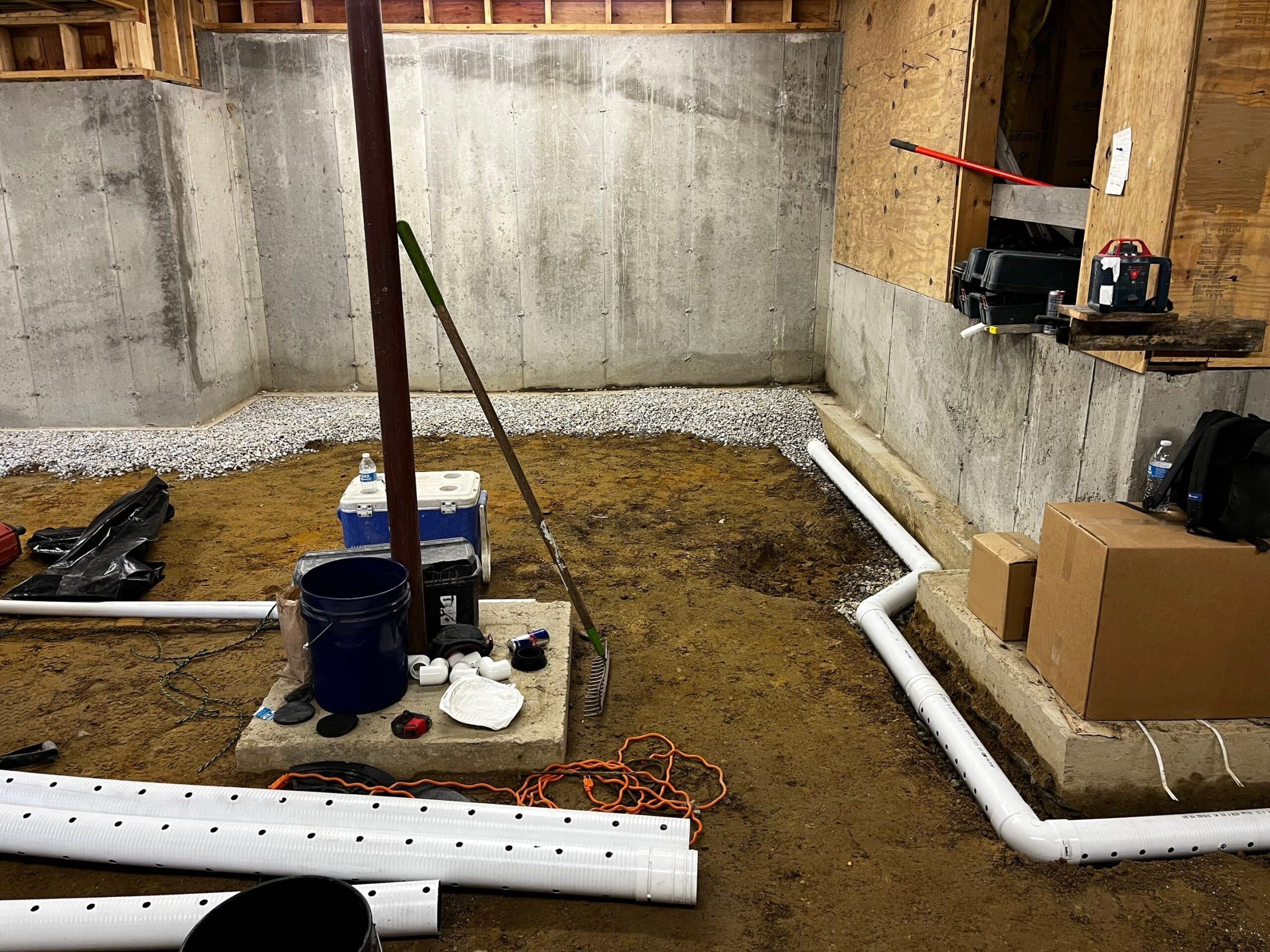
Step 3: Prep the Slab
Once the drains are in place we will lay down at least 2 inches of crushed stone around the entirety of the basement. We will then place a 14mm vapor barrier over the top of the crushed stone to prevent your concrete from wicking up moisture.
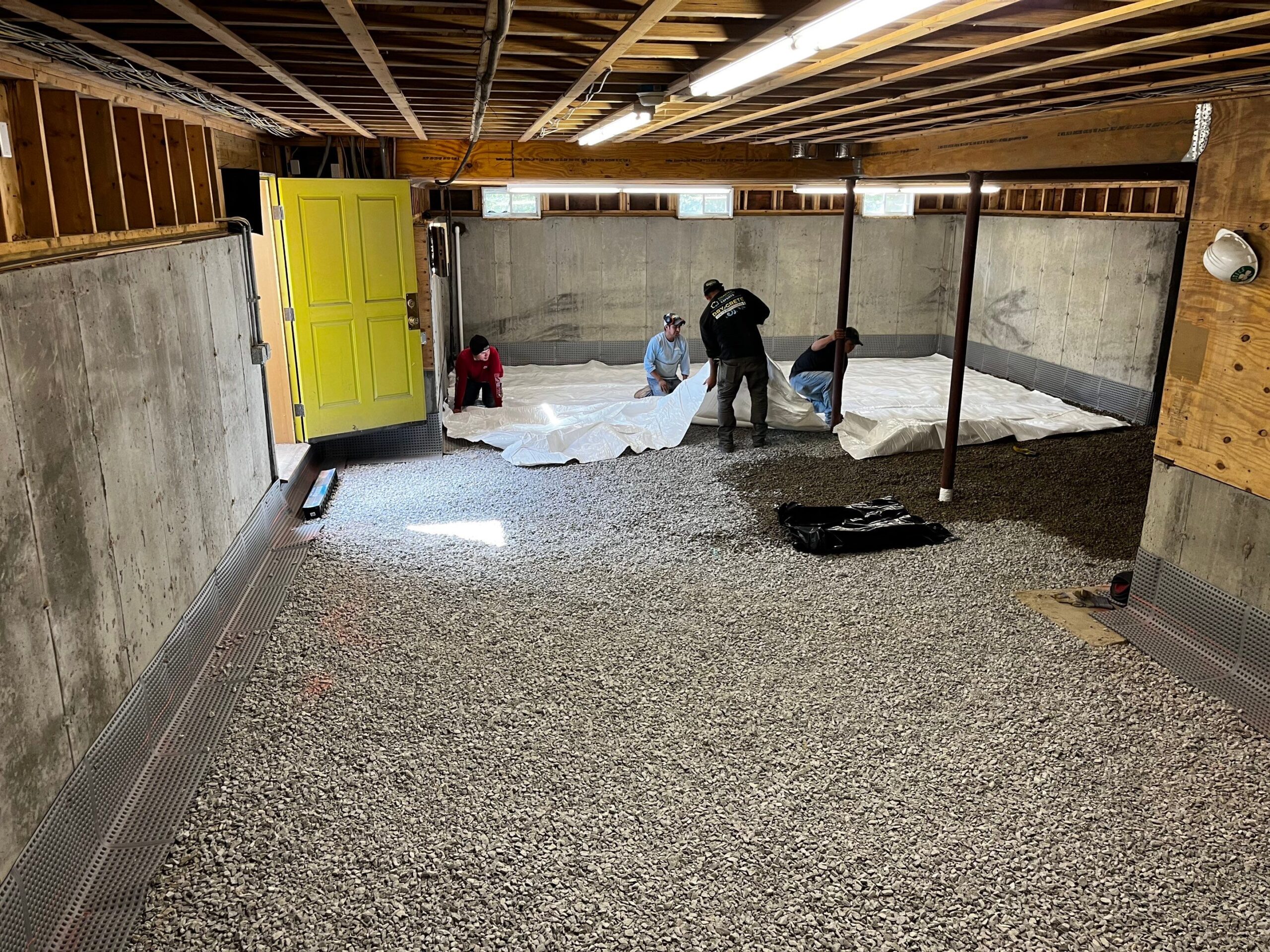
Step 4: Pour Your New Slab
The final step is to pour a new 4-inch concrete slab. During this process we install zip strips in the slab that act as relief joints during the curing process.
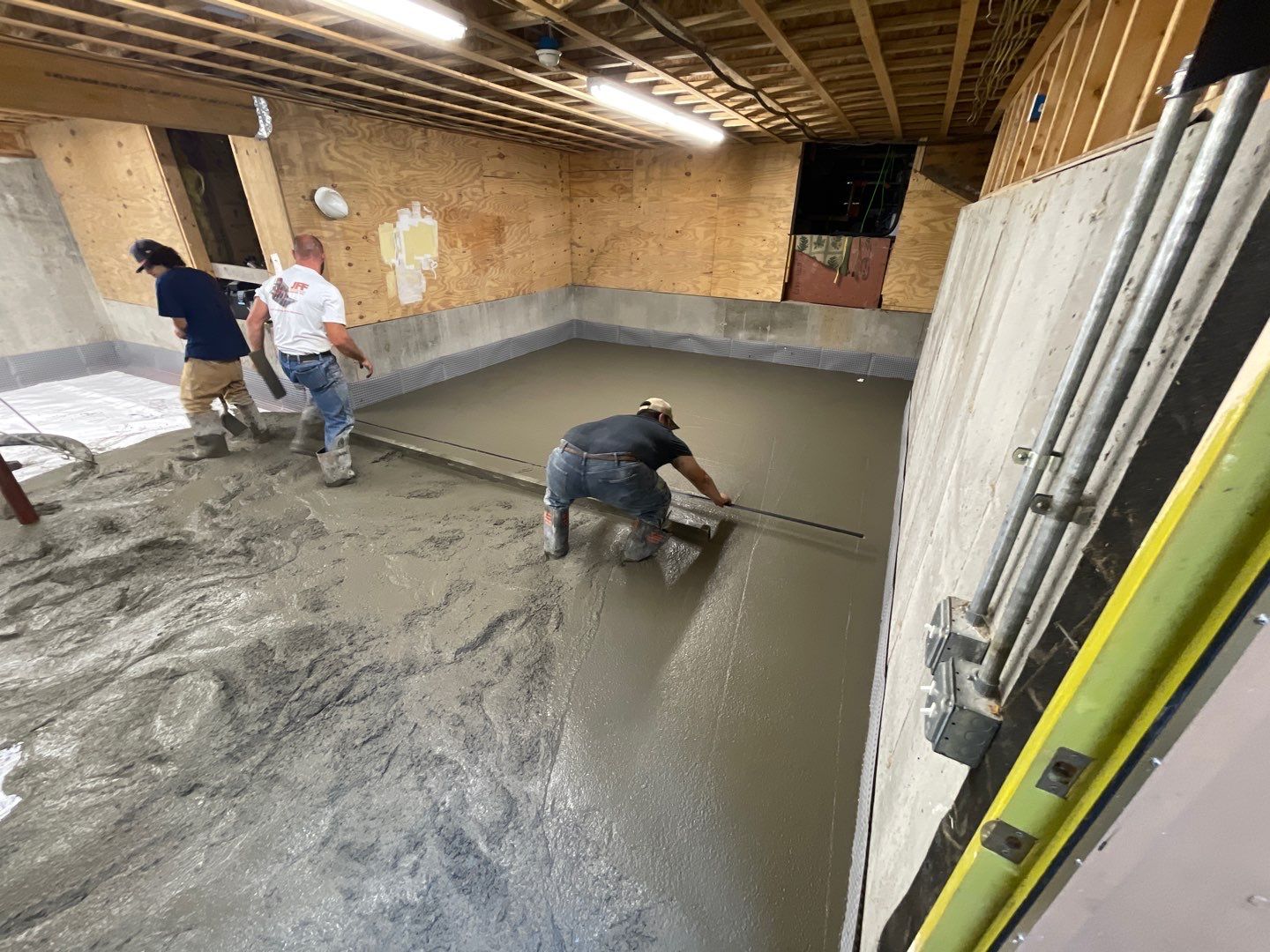
Managing Cracks: Why Zip Strips Are Used
Concrete is a robust and durable material, but it is not immune to the natural forces at play during the curing process. As concrete dries and hardens, it undergoes a process known as shrinkage, caused by the evaporation of excess water. This shrinkage can create internal stress, leading to cracks. Without proper measures to manage this stress, cracks can appear randomly across the slab, potentially affecting both its appearance and structural integrity.
The Role of Zip Strips
Zip strips are an essential tool in controlling cracking. These strips act as intentional weak points in the concrete, strategically placed to guide the cracking process. Here’s how they work:
- Guiding Stress: As the concrete cures and shrinkage occurs, zip strips ensure that cracks develop along pre-defined lines.
- Maintaining Integrity: By focusing cracking in specific areas, zip strips protect the rest of the slab, ensuring that it remains structurally sound and free of random fractures.
This controlled approach is comparable to perforated paper—just as the perforation makes tearing along a specific line easier, zip strips guide where the concrete will naturally crack.
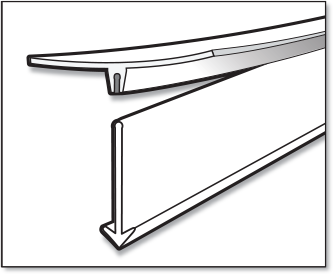
What To Expect With Zip Strips
It’s entirely normal to see visible cracks along the zip strip lines after the slab has cured. These relief cracks are a sign that the zip strips are functioning as intended. Key points to keep in mind:
- These cracks are expected and part of the design, helping to prevent random or uncontrolled cracking across the slab.
- Because the cracks are controlled and limited to specific areas, they do not compromise the slab’s strength or durability.
- The relief joints provide a cleaner, more uniform look compared to random cracking.
By using zip strips, your slab is designed to last longer and perform better, providing both functionality and peace of mind.
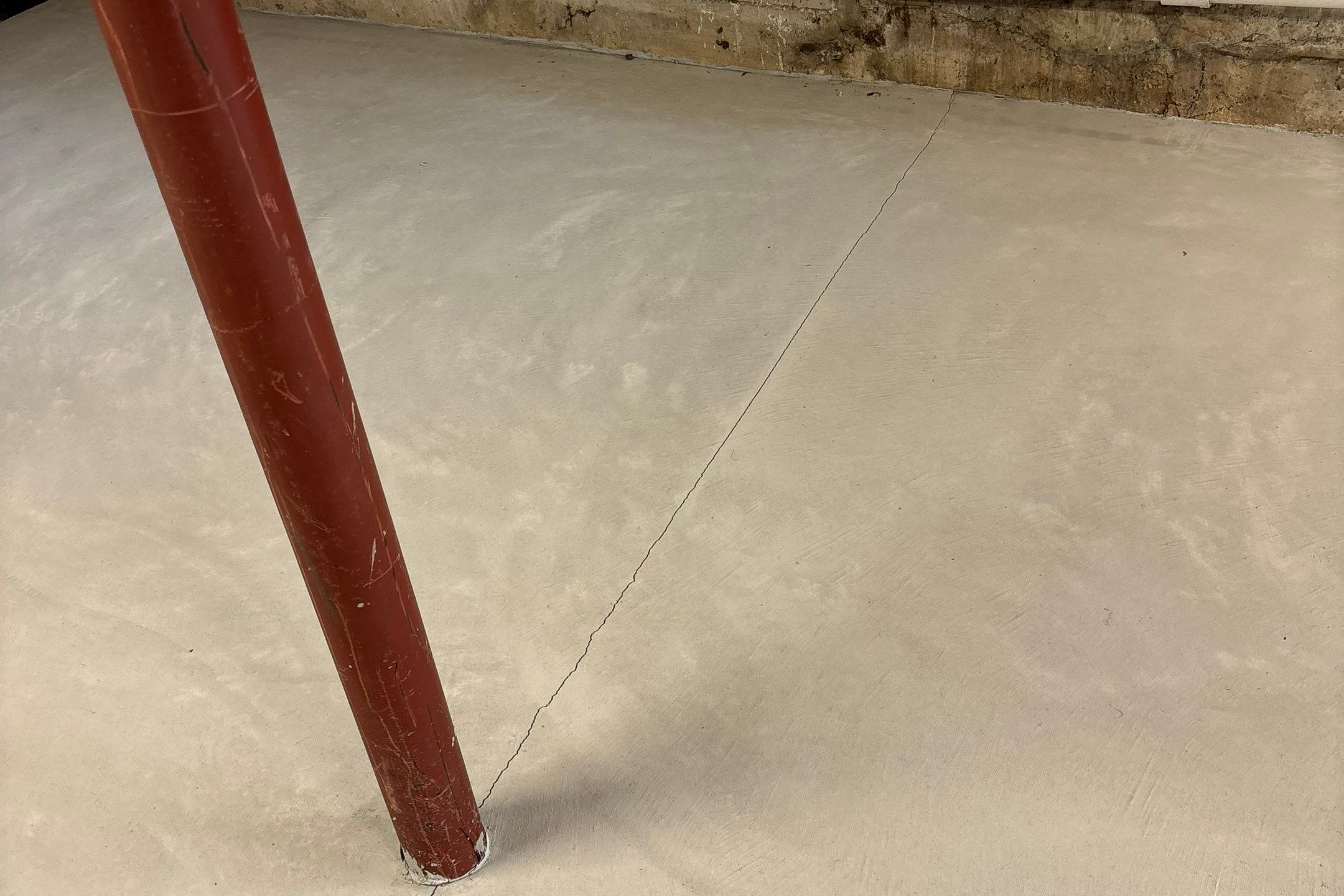
POST INSTALLATION: WHAT TO EXPECT
Once your new slab is poured, it enters a critical curing phase. During this time, you may notice changes in appearance and texture, which are normal. Understanding what to expect ensures your slab performs as intended for years to come.
Initial Appearance
Freshly poured concrete may not look “finished” immediately after installation, which is entirely normal. As it begins to cure, you might notice:
- Relief Cracks Along Zip Strips: These controlled cracks will start appearing as the concrete naturally shrinks. They’re intentionally placed to protect the slab’s structural integrity and are no cause for concern.
- Surface Variations: The surface of the concrete may show slight differences in texture or color as moisture evaporates and the curing process progresses. These are temporary and often resolve as the slab fully cures.
Understanding these initial characteristics can help set realistic expectations and ensure confidence in the longevity and durability of your new slab.
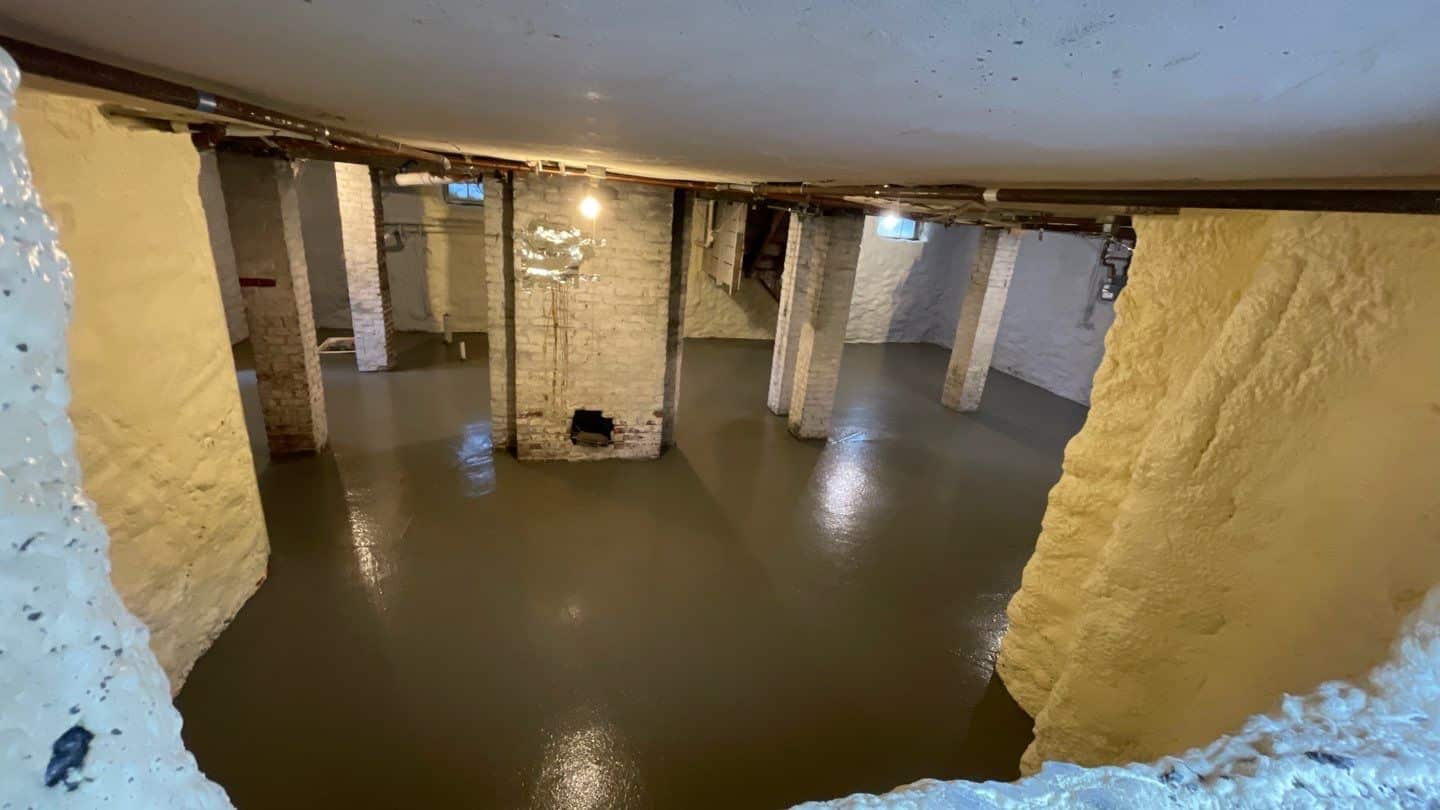
Curing Process
The 28-day curing period is the most critical phase for your new concrete slab, as this is when it develops its full strength and durability. While the slab may appear solid within hours of pouring, its internal structure is still undergoing a chemical process called hydration, where water reacts with cement to harden and strengthen the material. Here’s what to know:
- In the first 7 days, the concrete gains approximately 70% of its final strength.
- Over the next 21 days, it continues to harden, reaching its maximum durability by the 28th day.

Using Your New Slab
Knowing when and how to use your new slab is key to ensuring its longevity. Here’s what to keep in mind:
- Light Use After 1 Week: After the first 7 days, light foot traffic is generally safe, but avoid dragging heavy objects or exposing the slab to excessive weight.
- Wait for Heavy Loads: Hold off on placing heavy equipment, furniture, or vehicles on the slab until after the full 28-day curing period. This prevents stress on the concrete while it’s still hardening.
- Avoid Chemicals: During the curing phase, avoid using deicing salts or harsh chemicals, which can weaken the surface or cause discoloration.
These simple precautions during the early stages of use can significantly enhance the durability and appearance of your new slab.
Have any questions?
If you have any questions or concerns at any stage of the process, we’re here to help. Don’t hesitate to reach out to our team—we’re happy to provide guidance, answer your questions, and ensure your new basement slab meets all your expectations. Your satisfaction is our top priority!
Over 11,000 Appreciative Customers
Reviews
5.0
★★★★★ 5/5
Over 800 reviews
youchao
11 months ago
Drycrete did a great job fixing the leak, the technician came in time and explained things very clear and easy to understand. Answered all my questions after job is done. Highly recommended and their price is very reasonable as well compare to other quotes I got.
Debbie Medvinsky
11 months ago
My husband and I will be Drycrete customers for life. Can’t say enough how much we appreciate Drycrete and specifically the owner, Jason. It’s not often that you find someone who takes such personal care in their clients’ experience and repeatedly goes the extra mile to see that a job is done right and to the client’s satisfaction, and that is exactly what Jason has done for us.
Our house happens to be situated on a very high water table which means that we have a very active sump pump. Jason and his team helped ensure that we have the most effective pump configuration to ensure that we’re keeping the finished basement dry.
The team at Drycrete has been fantastic to work with and as we all know, it always starts at the top. Jason was personally involved in every step of the process, from the initial installation to follow up visits to adjust the float levels as necessary to find the right pumping frequency and has been incredibly responsive and helpful the entire time.
We thank Jason and the entire Drycrete team for their help in giving us the peace of mind that we have a dry basement thanks to the best pumping solution possible for our home.
Our house happens to be situated on a very high water table which means that we have a very active sump pump. Jason and his team helped ensure that we have the most effective pump configuration to ensure that we’re keeping the finished basement dry.
The team at Drycrete has been fantastic to work with and as we all know, it always starts at the top. Jason was personally involved in every step of the process, from the initial installation to follow up visits to adjust the float levels as necessary to find the right pumping frequency and has been incredibly responsive and helpful the entire time.
We thank Jason and the entire Drycrete team for their help in giving us the peace of mind that we have a dry basement thanks to the best pumping solution possible for our home.
Tess
11 months ago
Drycrete installed a complete waterproofing system in my basement, replaced the bulkhead and installed new window wells. HIGHLY professional and SUPERIOR work!! I am very impressed with their professionalism and work ethic. Thank you VERY MUCH Alex, Carlos, Sean, Mario, Mike and Brian. Forever grateful!
Felicia Captain
11 months ago
Great experience with Drycrete! Super knowledgeable and were able to help me with a very unique situation. Strongly recommend!
Julie C
11 months ago
Steve very cleverly diagnosed a dehumidifier that wasn't working (fan running so it seemed to be working) versus quoting us a very expensive solution as another company had done. Very much appreciated!! Max did a quick, clean, efficient, friendly install of a new dehumidifier two days later.
ted janas
11 months ago
Drycrete is fantastic!!
They did exactly what they said they would do in a professional and timely manner. What more could you ask for?
The guys were great and they did a fantastic job waterproofing our 12,000 sq ft basement. They sealed cracks and installed dehumidifiers.
This is a great company from the first phone call all the way through. Don't hesitate to contact them.
They did exactly what they said they would do in a professional and timely manner. What more could you ask for?
The guys were great and they did a fantastic job waterproofing our 12,000 sq ft basement. They sealed cracks and installed dehumidifiers.
This is a great company from the first phone call all the way through. Don't hesitate to contact them.
Ellyn Penn
12 months ago
I couldn’t be more satisfied with Drycrete! In March of 2020, 2 days before the world stopped, Drycrete came to my house to fix the water problem that I have had in my home for the last 20 years! Every large storm, I would have water in my basement, leaving me in knee high boots and wet vacs cleaning up the disaster , replacing carpets and repairing walls. After the most recent storm, I reached out to make sure that my pump was still good because I smelled an odor that I couldn’t identify. They sent someone right out, checked the entire system and put me on an annual check from now on! I could not be more pleased with DRYCRETE . Instead of being terrified of rainstorms, I am confident that my house will be safe and dry.
Katie McLean
1 year ago
From start to finish, Drycrete was amazing! Their customer service is fantastic. The team of 7 that did our basement could not have been nicer or worked harder. They finished in one day instead of 2, and the final outcome was amazing! We couldn’t recommend Drycrete more!
Lisa Hall
1 year ago
Great customer service! They were very efficient and did a great job installing the pump.
Owen Mael
1 year ago
Great company and work. I used them a few years ago and when it was time to expand my system, I immediately called them. Team was efficient and clean.
Leandra Eich
1 year ago
My review isn't much different from anyone else's - these people are consummate professionals who are very, very good at what they do. They did an entire basement dig-out for my customers - we gained 18" of ceiling height and it transformed the space. For such a large, seemingly complex job, they made it look easy (even though I KNOW it was not!) and with so few hiccups. I would use them again in a heartbeat.
Kevin Cimo
1 year ago
Fantastic experience. They're extremely knowledgeable and confident in their work. I got a handful of quotes from other companies large and small, they were the best at assessing and explaining everything, and pricing was actually the most reasonable as well. Would use them again in a heartbeat.
Joe Morocco
1 year ago
it was a very positive rewarding experience working with this company. I would recommend anybody to use them
Marie Lindholm
1 year ago
Gian arrived promptly. Very knowledgeable and courteous. Explained what he was going to be doing & promptly went to work. Upon finishing, he showed me the work he performed and explained the operation of the pumps and set me up with the application. Very happy with his work and he answered whatever questions I had. I would be happy to recommend Drycrete to anyone who should need water mitigation. Gian is a great asset to your company.
Laura Zollner
1 year ago
I was very pleased with the project we had completed by Drycrete Waterproofing! Everything from the estimate, to the professionalism of the workers, to the meticulous cleaning they did after they installed our sump pump exceeded my high expectations. I would definitely recommend!
J Long
1 year ago
Technicians arrived ahead of time. They were done replacing both sump pumps under an hour. Quality workmanship by a great company. I have been using Jason @ Drycrete since 2015. They are the go to people to keep your basement dry.
J.Long 5/24
J.Long 5/24
R Cotter
1 year ago
The Drycrete Team worked very quickly and did a very professional job on the french drain and sump pump installation along with a drain off in our yard. They cleaned up afterwards and left the yard and cellar clean. I’m unable to comment on functionality until we experience unusual rainfall, though my assumption is that it should work fine!
Marie Lindholm
1 year ago
Gian arrived promptly. Very knowledgeable and courteous. Explained what he was going to be doing & promptly went to work. Upon finishing, he showed me the work he performed and explained the operation of the pumps and set me up with the application. Very happy with his work and he answered whatever questions I had. I would be happy to recommend Drycrete to anyone who should need water mitigation. Gian is a great asset to your company.
